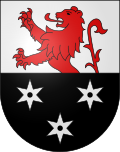Bursinel
| Bursinel | |
|---|---|
| State : |
|
| Canton : |
|
| District : | Nyon |
| BFS no. : | 5852 |
| Postal code : | 1195 |
| UN / LOCODE : | CH BUR |
| Coordinates : | 512901 / 143692 |
| Height : | 428 m above sea level M. |
| Height range : | 372–437 m above sea level M. |
| Area : | 1.78 km² |
| Residents: | 471 (December 31, 2018) |
| Population density : | 265 inhabitants per km² |
| Website: | www.bursinel.ch |
| Location of the municipality | |
Bursinel is a municipality in the Nyon district in the canton of Vaud in Switzerland .
geography
Bursinel is 428 m above sea level. M. , 8 km northeast of the district capital Nyon (air line). The farming village extends on the southern edge of the plateau at the foot of the Vaudois Côte, in a panoramic position around 50 m above the lake level of Lake Geneva .
The area of the 1.8 km² municipal area comprises a small section on the north-west bank of Lake Geneva. The municipality floor extends from the lake shore to the northwest over the flat edge of the bank and the subsequent steep slope to the plateau and the Fossy stream . The highest point of Bursinel is 435 m above sea level. M. reached on this plateau. In 1997, 13% of the municipal area was accounted for by settlements, 12% by forests and woodlands and 75% by agriculture.
Bursinel includes the hamlet L'Oujonnet ( 425 m above sea level ), also located on the edge of the plateau, as well as some farms. Neighboring municipalities to Bursinel are Dully , Bursins , Gilly and Rolle .
population
With 471 inhabitants (as of December 31, 2018), Bursinel is one of the small communities in the canton of Vaud. Of the residents, 82.2% are French-speaking, 6.7% German-speaking and 5.3% English-speaking (as of 2000). The population of Bursinel was 187 in 1850 and 199 in 1900. After 1980 (164 inhabitants) there was a rapid increase in population, with the number of inhabitants doubling within 20 years.
economy
Bursinel was a predominantly agricultural village until the second half of the 20th century . Agriculture still plays an important role as a livelihood for the population. There is an extensive wine-growing area on the steep slope below the village . Mainly arable farming is practiced on the fertile soils of the plateau . Further jobs are mainly available in the service sector. In the last few decades the village has developed into a residential community thanks to its attractive location. Many of the employed people are commuters who work primarily in Nyon .
traffic
Although the community is located away from major thoroughfares, it is still well developed in terms of traffic. It can be easily reached from main road 1 , which leads from Geneva along the lake shore to Lausanne . On April 14, 1858, the section from Morges to Coppet of the Lausanne-Geneva railway line with a station in Bursinel was put into operation. Today, however, no more trains stop in Bursinel.
history
The first written mention of the place took place in 1139 under the name Brucines , in 1220 the spelling Brucinais appeared . In the Middle Ages, Bursinel was under the rule of Mont-le-Vieux. The Carthusian monastery of Oujon (near Arzier ) also owned land in the municipality. From 1527 onwards, the castle of Bursinel was the gathering place of pro-Savoy nobles who besieged the city of Geneva twice. The Confederates , called for help by Geneva, destroyed the castle in 1530.
With the conquest of Vaud by Bern in 1536, Bursinel came under the administration of the Bailiwick of Morges . After the collapse of the Ancien Régime , the village belonged to the canton of Léman from 1798 to 1803 during the Helvetic Republic, which then became part of the canton of Vaud when the mediation constitution came into force .
Attractions
The Saint-Hilaire chapel was mentioned as early as 1139. It has been a parish church since the 13th century. Bursinel Castle was rebuilt after the fire. Most of the current buildings date from the 18th century, while the keep of the medieval castle has been preserved. There is a manor house at the Oujonnet winery, formerly owned by the Oujon Monastery. Villa Choisi, built in 1828, is located in a park on the lake shore.
Personalities
- Otto Frei (1924–1990), Swiss journalist and writer, lived here and died here
literature
- Paul Bissegger: Les monuments d'art e d'histoire du Canton de Vaud, Tome VII: Rolle et son district. Edited by the Society for Swiss Art History GSK. Bern 2012 (Art Monuments of Switzerland, Volume 120) ISBN 3-7643-1208-4 . Pp. 52-65.
Web links
- Official website of the municipality of Bursinel (French)
- François Vodoz: Bursinel. In: Historical Lexicon of Switzerland .
- Aerial photography
Individual evidence
- ↑ Permanent and non-permanent resident population by year, canton, district, municipality, population type and gender (permanent resident population). In: bfs. admin.ch . Federal Statistical Office (FSO), August 31, 2019, accessed on December 22, 2019 .



